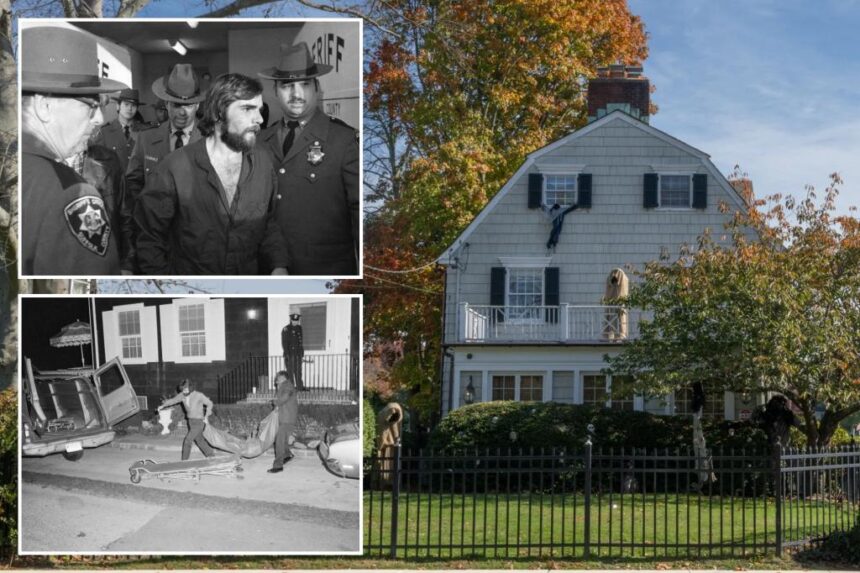Upon first glance, the charming three-story home with black shutters and a wrought-iron fence seems like the epitome of the American Dream.
However, upon closer inspection, you realize: it’s that house.
The five-bedroom, four-bathroom Dutch Colonial on Ocean Avenue in Amityville was the location of one of New York’s most infamous mass murders, where a young man shot all six members of his family as they slept with a .35-caliber Marlin rifle, one by one.
The bloodshed caused by Ronald DeFeo Jr. on the morning of November 13, 1974, was like something out of a horror movie, and it eventually inspired the 1979 classic “The Amityville Horror” starring Margot Kidder and James Brolin as a couple who purchase and move into the vacant house after the murders, only to encounter a demonic presence.
DeFeo, then 23, was a heavy drug user known as “Butch.” Over the years, he attributed the massacre to everything from voices in his head to hired killers to his own sister.
He was convicted of killing his parents, Ronald and Louise; his two sisters, Dawn, 18, and Alison, 13; and his two brothers, Marc, 12, and John, 9, and received six terms of 25 years to life in prison.
He was never granted parole. In 2021, at the age of 69, he passed away at Albany Medical Center, near the Sullivan Correctional Facility in upstate Fallsburg, where he was incarcerated. The cause of his death was never disclosed.
On the 50th anniversary of DeFeo’s horrific act, the stigma of the crime is something that the small town of Amityville, with a population of 9,500, cannot seem to shake, no matter how hard it tries.
Laura DiDio was an intern and trainee reporter at the Long Island Press when she got the exclusive story on a crime that shocked the village and the world.
“New York in the mid-1970s was no stranger to murder, but Amityville certainly was,” she told The Post.
“It’s an upscale, mostly middle-class neighborhood, and they hadn’t experienced a murder in perhaps 50 or 60 years. Local men had died in the Korean War and Vietnam, but nothing like this had ever occurred.”
The legend truly took hold about a year after the murders.
In December 1975, during DeFeo’s trial, the three-story home was purchased by newlyweds George and Kathy Lutz for $80,000. They relocated from Brooklyn with Kathy’s three children, Daniel, 9, Christopher, 7, and Melissa, 5, known as “Missy.”
Soon after moving in, the Lutzes claimed to have encountered various paranormal occurrences, including slime seeping from the walls, sudden drops in temperature, and strange noises and odors.
George reported waking up at 3:15 a.m. each day – the same time DeFeo began his killing spree – while Kathy said she levitated above her bed. These experiences were documented in the bestselling 1977 book “The Amityville Horror: A True Story,” based on the Lutzes’ encounters.
The children started sleeping on their stomachs, the same position DeFeo’s victims were found in, and Missy claimed to have a new friend: a demonic pig named “Jodie.”
When a local Catholic priest, Father Ralph J. Pecoraro, came to bless the house, he fled, claiming he heard a voice telling him to “Get out,” as George told the media at the time.
Just 28 days after moving in, the Lutzes left, with their stay being so brief that they never made a single payment on the $60,000 mortgage.
The Lutzes’ account became a boon for fans of the supernatural.
Two years after the book was published, the movie adaptation was released, marking the beginning of a successful franchise that has spawned over 20 films.
“It’s a story that continues to capture attention,” said DiDio, who co-produced a 2012 documentary titled “My Amityville Horror.”
“It has become a brand. In fact, Amityville is more like a cottage industry.”
Alexandra Holzer, a paranormal investigator and the daughter of Dr. Hans Holzer, a parapsychologist who investigated the house in the 1970s, believes that the house itself was not haunted, but the land it was built on may have been.
“My father theorized that DeFeo Jr. could have been possessed by an old American Indian chief and that greedy developers constructed the house on a sacred Native American burial ground,” explained Holzer.
“He believed that all the disturbances in that house stemmed from this little-known fact.”
Since the murders, the book, and the films, countless visitors have flocked to the property, eager to witness what was dubbed “the most haunted house in the world.”
Among the crowds, who sometimes even sailed up the creek to get a glimpse of the house from the back, was a particularly eerie visitor in 1984.
Ricky Kasso, a devil-worshipping, drug-using teenager from Northport, Long Island, was known to frequent the house. He brutally murdered his 17-year-old friend Gary Lauwers, stabbing him over 30 times, in their hometown on June 19, 1984, before taking his own life before facing trial.
Since the original murders in 1974, the 3,600-square-foot property on Ocean Avenue has changed ownership multiple times, with one set of owners, Jim and Barbara Cromarty, even altering the address to deter the curious.
Subsequent owners made renovations to the house, such as changing the distinctive upper floor eye-windows, adding a sunroom, renovating the kitchen, and finishing the basement. None of these owners reported any paranormal activity.
In 2000, The Amityville Record revisited the house, describing life on Ocean Avenue as “fairly routine,” with occasional visits from the curious and believers in the supernatural. Ultimately, it was just another house in Amityville with a tragic history.
During a recent visit by The Post to the town, some neighbors had adorned their homes with Halloween decorations that playfully alluded to the “horror.”
The property was last sold for $605,000 in 2017 but is currently estimated to be valued at $1,137,300, according to Zillow.
The current owners of the property declined to comment, as did the surviving children of the late Lutzes, the mayor of Amityville, and the local church.
“Towns often prefer to bury such incidents – no pun intended – as they are not good for business,” said Holzer.
But the past never remains buried for long.
“The desire for interest will never truly be quelled because that is the essence of human nature,” she added.





